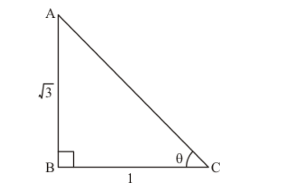If $\cot \theta=\frac{1}{\sqrt{3}}$, show that $\frac{1-\cos ^{2} \theta}{2-\sin ^{2} \theta}=\frac{3}{5}$.
Given: $\cot \theta=\frac{1}{\sqrt{3}}$....(1)
To show that $\frac{1-\cos ^{2} \theta}{2-\sin ^{2} \theta}=\frac{3}{5}$
Now, we know that $\cot \theta=\frac{1}{\tan \theta}$
Since $\tan \theta=\frac{\text { Perpendicular side opposite to } \angle \theta}{\text { Base } \text { side } \text { adjacent to } \angle \theta}$
Therefore,
$\cot \theta=\frac{1}{\frac{\text { Perpendicular side opposite to } \angle \theta}{\text { Base side adjacent to } \angle \theta}}$
Therefore,
$\cot \theta=\frac{\text { Base side adjacent to } \angle \theta}{\text { Perpendicular side opposite to } \angle \theta}$....(2)
Comparing Equation (1) and (2)
We get,
Base side adjacent to $\angle \theta=1$
Perpendicular side opposite to $\angle \theta=\sqrt{3}$
Therefore, Triangle representing angle $\theta$ is as shown below

Hypotenuse AC is unknown and it can be found by using Pythagoras theorem
Therefore by applying Pythagoras theorem
We get,
$A C^{2}=A B^{2}+B C^{2}$
Therefore by substituting the values of known sides
We get,
$A C^{2}=(\sqrt{3})^{2}+1^{2}$
Therefore,
$A C^{2}=3+1$
$A C^{2}=4$
$A C=\sqrt{4}$
Therefore,
$A C=2$...(3)
Now, we know that
$\sin \theta=\frac{\text { Perpendicular side opposite to } \angle \theta}{\text { Hypotenuse }}$
Now from figure (a)
We get,
$\sin \theta=\frac{A B}{A C}$
Therefore from figure (a) and equation (3) ,
$\sin \theta=\frac{\sqrt{3}}{2}$....(4)
Now, we know that
$\cos \theta=\frac{\text { Base side adjacent to } \angle \theta}{\text { Hypotenuse }}$
Now from figure (a)
We get,
$\cos \theta=\frac{B C}{A C}$
Therefore from figure $(a)$ and equation $(3)$,
$\cos \theta=\frac{1}{2}$...(5)
Now, L.H.S of the equation to be proved is as follows
L.H.S $=\frac{1-\cos ^{2} \theta}{2-\sin ^{2} \theta}$
Substituting the value of $\sin \theta$ and $\cos \theta$ from equation (4) and (5)
We get,
L.H.S $=\frac{1-\left(\frac{1}{2}\right)^{2}}{2-\left(\frac{\sqrt{3}}{2}\right)^{2}}$
L.H.S $=\frac{1-\frac{(1)^{2}}{(2)^{2}}}{2-\frac{(\sqrt{3})^{2}}{(2)^{2}}}$
L.H.S $=\frac{1-\frac{1}{4}}{2-\frac{3}{4}}$
Now by taking L.C.M. in numerator as well as denominator
We get,
L.H.S $=\frac{\frac{(4 \times 1)-1}{4}}{\frac{(4 \times 2)-3}{4}}$'
Therefore,
$L . H . S=\frac{\frac{4-1}{4}}{\frac{8-3}{4}}$
$L . H . S=\frac{\frac{3}{4}}{\frac{5}{4}}$
Therefore,
L.H.S $=\frac{3}{4} \times \frac{4}{5}$
$L . H . S=\frac{3}{5}=R . H . S$
Therefore,
$\frac{1-\cos ^{2} \theta}{2-\sin ^{2} \theta}=\frac{3}{5}$
Hence proved that $\frac{1-\cos ^{2} \theta}{2-\sin ^{2} \theta}=\frac{3}{5}$
Click here to get exam-ready with eSaral
For making your preparation journey smoother of JEE, NEET and Class 8 to 10, grab our app now.
